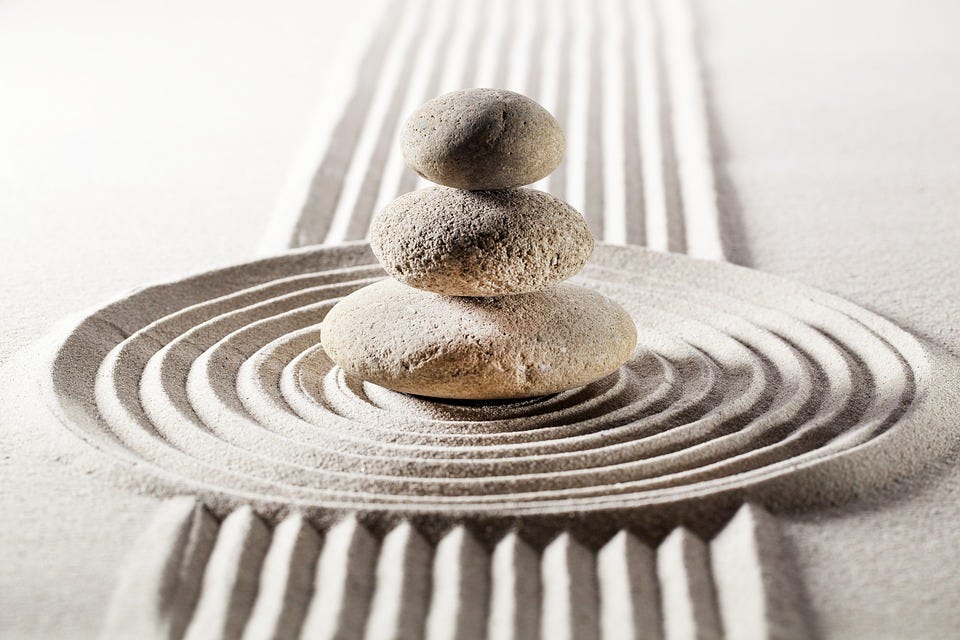S
Subhash Kak
Guest

Meditation stones/ Pixabay
Yoga is everywhere in free nations, whether you are in small town or big city, in the Old World or the New World. It is taught and practiced in schools and homes and over the Internet.
Yoga studios are congregational places where the bonds of friendships are secured, quite as in the original meaning of religion (Latin religare, “what binds”).
But why do I use the word Yogatva — — rather than Yoga — — which in the dictionary means “connected with the state of Yoga”? Because, in the minds of many, Yoga has become associated primarily with the asanas, body postures, when discerning persons know it is much, much more.
The asanas are the doorway that opens up an entire world of training not only the body but also the mind to take one to the deepest mystery of all, namely the source and nature of consciousness.
Yogatva, the heart of yoga, takes one on a personal journey of discovery in different ways that include art, dance, music, architecture, and even science. It provides personal fulfillment, it can even help the body to recover its natural state of ease.
It is the harnessing of one’s “I” to make a paradoxical leap beyond one’s ego, annihilating it, and reaching a space that transcends it and connects one to everyone else.
The body is the mirror to the universe and so if universe is sacred (sacer, what is dedicated and purified), so is the body. It sacrality comes from its inner transformations (sacrifice).
Like the body, the physical universe is a flux in which the spirit is constant. It is like a rapidly moving disk whose center is fixed.
The practice of Yoga is to find the interconnections in the various processes within to be in the ineffable space where matter and spirit become one.
Once the center has been discovered and the state of stillness within the movement apprehended, calm and understanding ensue.
Discovery and healing
For mastery, observe the flows between the brain, mind, body, and behavior, or play with memory, breath, beat and sound, and dance between body and mind and back; or be absorbed in one’s own creative path.
Yogatva is not just strategies for positive states of the mind; it helps one become creative, and provides strength to deal with inner pain.
The path begins with recognition of the paradox that the body and mind are both different and the same. One is the body in which the mind resides, but one is also the mind that observes the body.
Deep experience emerges from the stretching of the body and mind that transcends their mutual divide.
In an ancient dialogue in the Kaṭha Upaniṣad (KU), a distinction is made between what is pleasant and dear (preya, related to the body or the mind) and good (śreya, related to the state that goes beyond the distinction).
It says:
The wise one chooses the good over the pleasant,
The fool, acquisitive and craving, chooses the dear.
Just as the outer world is set in motion by the interplay of opposites, the inner world finds dynamism in layered oppositions. If the oppositions overwhelm then there is stress and pain, but if one knows the patterns to this whirling dance, it becomes creative energy.
KU defines Yoga:
यदा पञ्चावतिष्ठन्ते ज्ञानानि मनसा सह ।
बुद्धिश्च न विचेष्टते तामाहुः परमां गतिम् ॥ १० ॥
तां योगमिति मन्यन्ते स्थिरामिन्द्रियधारणाम् ।
अप्रमत्तस्तदा भवति योगो हि प्रभवाप्ययौ ॥ ११ ॥
Only when the five senses and thoughts in the mind stand still,
and intellect does not waver, that they call the highest path.
That is what one calls Yoga, stilling of the senses, and focus,
It is not heedless slowness, Yoga is creation and dissolution.
Even the briefest intervention, such as a few minutes of focused breathing, has beneficial effects. With self-discovery comes healing.
Art
Art imitates life not only in the apprehension of beauty but also in the choices the creator of art must make.
Whether it is sculpture, music, poetry, dance, or architecture, the artist must come in from the outside and find an anchor that binds the composition so that the details are part of the whole.
If Yoga takes one from one’s mind and body to deep experience that embraces all, creativity in art is a process that takes one from personal sensibility to universal beauty. This creativity emerges from a state of Yogatva.
Reference
Kak, S. (2019) Life and yoga. https://www.academia.edu/47815092/Life_and_Yoga
Continue reading...
